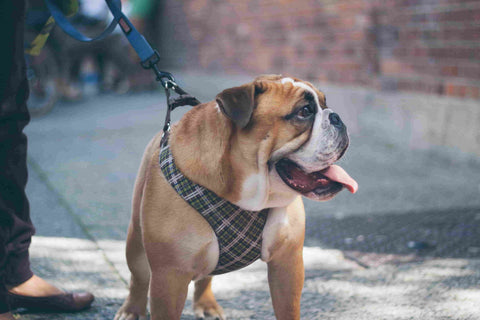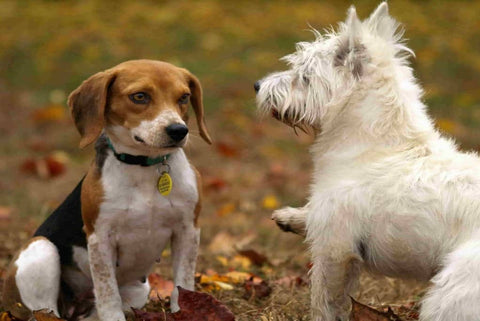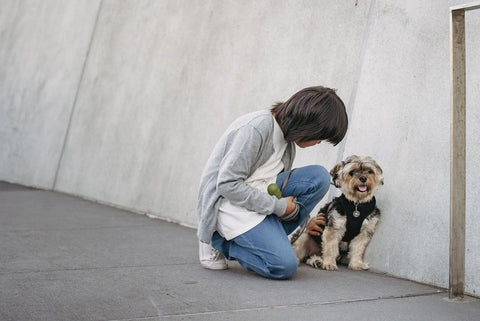How to Choose the Best Back Clip Dog Harness
The most common type of harness that you'll see both in pet stores and on walks is the back-clip dog harness. Pet owners use back-clip harnesses for activities such as down walking, training, sports, and mor
In this article, we will explore the basics of choosing a back clip dog harness. Let’s also discuss its proper usage for different cases and compare it against front clip harnesses - the alternative option.
When Should You Use Back Clip Dog Harness?
There are a few scenarios where you might consider using a back clip harness for dogs instead of the traditional front-clip harness.
For Walking
If your dog pulls on the leash or is particularly strong, a back clip harness can give you more control over them while walking. This type of harness puts pressure on the chest and shoulders instead of their throat, so it's also a good option for dogs who are sensitive around their necks.
For Training
A back clip harness can be helpful if you're working on obedience training with your dog. It gives you more control over their movement and prevents them from pulling away from you.
For Sports: Hiking, Running, etc
If you're planning on doing any physical activity with your dog, a back clip harness is a good option. It's more comfortable and won't rub against the neck or throat like a front-clip harness.
For Traveling
A back clip harness can be a good option for traveling with your dog. It's more comfortable and won't rub against the neck or throat like a front-clip harness.
According to Insider, if you have a dog with breathing problems, you should use a harness rather than a collar. Wearing a collar can restrict a dog's breathing by putting pressure on the trachea.
A dog harness clip-on back might suit you if the following scenarios apply to your situation. If you're unsure which type of harness is right for your dog, talk to your veterinarian or a professional trainer. They can help you assess your dog's needs and find the best option for them.
Best Features of a Back Clip Harness for Dogs
Back clip harnesses differ from other dog harness types in several ways. Here are some of the best features to search for in a back clip dog harness:
- Comfortable Padding: A back clip harness should have comfortable padding that won't rub against your dog's skin or irritate its fur. Choose a harness made with breathable fabric and soft edges.
- Breathable Material: You want a back clip harness that is made from breathable material.,keeping your dog cool and comfortable, even during strenuous activity.
- Versatility: A back clip harness should be versatile enough to use in various situations. Look for an adjustable harness to fit your dog's unique body shape
- Durability: A harness should be made from durable materials that can withstand regular use. For a harness, seek one with reinforced stitching and sturdy hardware.
- Easy on & off: Look for a harness with adjustable straps and buckles that are convenient to adjust.
- Easy-to-clean: Choose a harness that can be machine-washed or wiped down with a damp cloth. Learn the best way to clean a dog harness by reading our tips.
Other features to look for in a best back clip dog harness include reflective straps, a top-mounted handle, wide and adjustable straps for a better fit, and the option of using both the front and back clip attachments. You can find these features and more at Pet&Cuddle's harnesses.
How to Put a Harness with a Back-Clip on a Dog?
Putting a back-clip harness on a dog is easy with the proper steps.
- Choose the right size. The harness should fit snugly around your dog's chest and shoulders without being too tight.
- Put the harness on. Place the harness over your dog's head and adjust the straps to fit snugly. You may need to help direct their head and front legs through the hole.
- Attach the back clip. Once the harness is in place, attach the back clip to the D-ring on the harness. The D-ring of the harness should sit right in the center of your pet's back.
- Adjust the straps. Ensure the straps are adjusted correctly so that the harness is comfortable for your dog to wear.
- Go for a walk. Once the harness is in place, you're ready to go for a walk with your dog.
Unsure of the appropriate size harness for your furry friend? Check out our guide to help you make the best decision.
Back Clip Dog Harness vs. Front clip: Which One is Better?
Now that we know how to put on a harness with a back clip for dogs, let's talk about the pros and cons of a front clip dog harness vs. a back clip one.
The main difference between a back clip dog harness and a front clip dog harness is the location of the D-ring. A back clip harness has the D-ring located near the shoulder blades at the back of the harness. It allows your dog more freedom of movement and prevents the harness from restricting breathing or movement.
Pros and Cons of Back-Clip Harnesses for Dogs
There are many things to consider before you decide whether to buy a back-clip or front-clip harness for your dog. The pros and cons of these harnesses are listed below:
Pros
- Harnesses are easier to put on and take off than front-lead designs.
- Back leads make leash walking easier for dogs.
- Your dog leash-pulling will soon be a thing of the past.
- The more even weight distribution better protects your dog's neck region.
- Having a lead makes it less likely for your dog to get tangled under its legs.
Cons
- It gives you less authority over dogs that are not well-trained and jump or pull compared to a front lead harness.
Pros and Cons of Front-Clip Dog Harnesses
Pros
- It enhances control against pulling from unmanageable canines and leash-trained dogs.
- Easier to steer dogs means less work for you.
Cons
- Leashes often get wrapped around a dog's front legs.
- Front lead harnesses are complicated for some dog owners to put on and take off.
- Many front leashes harness on the market are not ergonomically designed and can cause chest and neck discomfort or injuries.
Pet MD notes that front-hook harnesses might disrupt a dog's natural stride and limit shoulder mobility. For these reasons, they may not be ideal for dogs who lead active lifestyles.
With Pet&Cuddle, you don't need to choose between these two options. Our dog harnesses have a two-clip design that allows for greater adaptability and comfort while wearing and is applicable for various activities with your pet.
Buy the Best Back Clip Dog Harnesses at Pet&Cuddle!
Are you looking for the best back clip harness for your furry friend? Look no further than Pet&Cuddle!
Our harnesses are made of high-quality materials and feature reflective straps, a top-mounted handle, wide and adjustable straps for a better fit, and the option of using both the front and back clip attachments. Shop our harnesses today and find the perfect one for your pet!
Commonly Asked Questions About the Back Clip Dog Harnesses
Do you have any questions about finding your dog's best back clip harness? Rest assured, we've got you covered! The following are some of the most frequently asked concerns regarding why you should use a back clip harness for dogs.
What is a Back Clip Dog Harness?
A back clip harness has the leash ring on top of the dog's back when put on. These harnesses are particularly beneficial for tiny dogs with delicate tracheas that collars may injure.
Back-clip harnesses only work for dogs trained not to pull on the leash. The design does little to stop a dog from pulling and may make it worse by creating a sled-pulling action that drags the owner along in place of the sled.
Is a front clip or back-clip harness better for daily use?
A front clip dog harness is not the best option for daily use as it can restrict your dog’s movements if the leash is attached to its chest. On the other hand, you may use the back clip harness for small dogs for various activities with your dog, including walking, training, and sports.
Can a back-clip dog harness stop my dog from pulling?
Contrary to popular belief, harnesses do not encourage dogs to pull. They have the opposite effect and can be helpful training tools. The front clip of a saddle puts tension on a dog’s shoulder blades which helps train them against pulling.
There are several ways to discourage pulling, but none will work unless you follow through with regular training. A well-fitting leash doesn't necessarily mean that the dog has to wear a prong or no-pull harness as soon as it arrives.
Which material is best for a back clip dog harness?
The best back clip dog harness material should be gentle on your pup and built to last. Nylon is an ideal pick for those looking for a fabric with some give to it and can withstand constant wear. Additionally, the padding on harnesses may provide more comfort.




